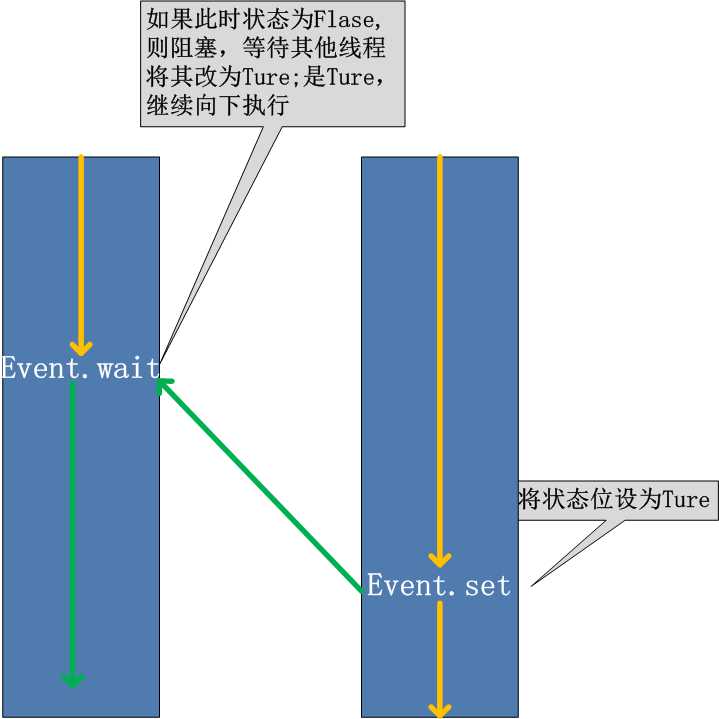python开发线程:死锁和递归锁&信号量&定时器&线程queue&事件evevt
Posted
tags:
篇首语:本文由小常识网(cha138.com)小编为大家整理,主要介绍了python开发线程:死锁和递归锁&信号量&定时器&线程queue&事件evevt相关的知识,希望对你有一定的参考价值。
一 死锁现象与递归锁
进程也有死锁与递归锁,在进程那里忘记说了,放到这里一切说了额
所谓死锁: 是指两个或两个以上的进程或线程在执行过程中,因争夺资源而造成的一种互相等待的现象,若无外力作用,它们都将无法推进下去。此时称系统处于死锁状态或系统产生了死锁,这些永远在互相等待的进程称为死锁进程,如下就是死锁


from threading import Thread,Lock
import time
mutexA=Lock()
mutexB=Lock()
class MyThread(Thread):
def run(self):
self.func1()
self.func2()
def func1(self):
mutexA.acquire()
print(‘\\033[41m%s 拿到A锁\\033[0m‘ %self.name)
mutexB.acquire()
print(‘\\033[42m%s 拿到B锁\\033[0m‘ %self.name)
mutexB.release()
mutexA.release()
def func2(self):
mutexB.acquire()
print(‘\\033[43m%s 拿到B锁\\033[0m‘ %self.name)
time.sleep(2)
mutexA.acquire()
print(‘\\033[44m%s 拿到A锁\\033[0m‘ %self.name)
mutexA.release()
mutexB.release()
if __name__ == ‘__main__‘:
for i in range(10):
t=MyThread()
t.start()
‘‘‘
Thread-1 拿到A锁
Thread-1 拿到B锁
Thread-1 拿到B锁
Thread-2 拿到A锁
然后就卡住,死锁了
‘‘‘
解决方法,递归锁,在Python中为了支持在同一线程中多次请求同一资源,python提供了可重入锁RLock。
这个RLock内部维护着一个Lock和一个counter变量,counter记录了acquire的次数,从而使得资源可以被多次require。直到一个线程所有的acquire都被release,其他的线程才能获得资源。上面的例子如果使用RLock代替Lock,则不会发生死锁:
mutexA=mutexB=threading.RLock() #一个线程拿到锁,counter加1,该线程内又碰到加锁的情况,则counter继续加1,这期间所有其他线程都只能等待,等待该线程释放所有锁,即counter递减到0为止
二 信号量Semaphore
同进程的一样
Semaphore管理一个内置的计数器,
每当调用acquire()时内置计数器-1;
调用release() 时内置计数器+1;
计数器不能小于0;当计数器为0时,acquire()将阻塞线程直到其他线程调用release()。
实例:(同时只有5个线程可以获得semaphore,即可以限制最大连接数为5):


from threading import Thread,Semaphore
import threading
import time
# def func():
# if sm.acquire():
# print (threading.currentThread().getName() + ‘ get semaphore‘)
# time.sleep(2)
# sm.release()
def func():
sm.acquire()
print(‘%s get sm‘ %threading.current_thread().getName())
time.sleep(3)
sm.release()
if __name__ == ‘__main__‘:
sm=Semaphore(5)
for i in range(23):
t=Thread(target=func)
t.start()
与进程池是完全不同的概念,进程池Pool(4),最大只能产生4个进程,而且从头到尾都只是这四个进程,不会产生新的,而信号量是产生一堆线程/进程
三 Event事件
同进程的一样
线程的一个关键特性是每个线程都是独立运行且状态不可预测。如果程序中的其 他线程需要通过判断某个线程的状态来确定自己下一步的操作,这时线程同步问题就会变得非常棘手。为了解决这些问题,我们需要使用threading库中的Event对象。 对象包含一个可由线程设置的信号标志,它允许线程等待某些事件的发生。在 初始情况下,Event对象中的信号标志被设置为假。如果有线程等待一个Event对象, 而这个Event对象的标志为假,那么这个线程将会被一直阻塞直至该标志为真。一个线程如果将一个Event对象的信号标志设置为真,它将唤醒所有等待这个Event对象的线程。如果一个线程等待一个已经被设置为真的Event对象,那么它将忽略这个事件, 继续执行
event.isSet():返回event的状态值; event.wait():如果 event.isSet()==False将阻塞线程; event.set(): 设置event的状态值为True,所有阻塞池的线程激活进入就绪状态, 等待操作系统调度; event.clear():恢复event的状态值为False。

例如,有多个工作线程尝试链接MySQL,我们想要在链接前确保MySQL服务正常才让那些工作线程去连接MySQL服务器,如果连接不成功,都会去尝试重新连接。那么我们就可以采用threading.Event机制来协调各个工作线程的连接操作


from threading import Thread,Event
import threading
import time,random
def conn_mysql():
count=1
while not event.is_set():
if count > 3:
raise TimeoutError(‘链接超时‘)
print(‘<%s>第%s次尝试链接‘ % (threading.current_thread().getName(), count))
event.wait(0.5)
count+=1
print(‘<%s>链接成功‘ %threading.current_thread().getName())
def check_mysql():
print(‘\\033[45m[%s]正在检查mysql\\033[0m‘ % threading.current_thread().getName())
time.sleep(random.randint(2,4))
event.set()
if __name__ == ‘__main__‘:
event=Event()
conn1=Thread(target=conn_mysql)
conn2=Thread(target=conn_mysql)
check=Thread(target=check_mysql)
conn1.start()
conn2.start()
check.start()
四 定时器
定时器,指定n秒后执行某操作
from threading import Timer
def hello():
print("hello, world")
t = Timer(1, hello)
t.start() # after 1 seconds, "hello, world" will be printed
五 线程queue
queue队列 :使用import queue,用法与进程Queue一样
queue is especially useful in threaded programming when information must be exchanged safely between multiple threads.
- class
queue.Queue(maxsize=0) #先进先出


import queue q=queue.Queue() q.put(‘first‘) q.put(‘second‘) q.put(‘third‘) print(q.get()) print(q.get()) print(q.get()) ‘‘‘ 结果(先进先出): first second third ‘‘‘
class queue.LifoQueue(maxsize=0) #last in fisrt out


import queue q=queue.LifoQueue() q.put(‘first‘) q.put(‘second‘) q.put(‘third‘) print(q.get()) print(q.get()) print(q.get()) ‘‘‘ 结果(后进先出): third second first ‘‘‘
class queue.PriorityQueue(maxsize=0) #存储数据时可设置优先级的队列


import queue q=queue.PriorityQueue() #put进入一个元组,元组的第一个元素是优先级(通常是数字,也可以是非数字之间的比较),数字越小优先级越高 q.put((20,‘a‘)) q.put((10,‘b‘)) q.put((30,‘c‘)) print(q.get()) print(q.get()) print(q.get()) ‘‘‘ 结果(数字越小优先级越高,优先级高的优先出队): (10, ‘b‘) (20, ‘a‘) (30, ‘c‘) ‘‘‘
其他


Constructor for a priority queue. maxsize is an integer that sets the upperbound limit on the number of items that can be placed in the queue. Insertion will block once this size has been reached, until queue items are consumed. If maxsize is less than or equal to zero, the queue size is infinite. The lowest valued entries are retrieved first (the lowest valued entry is the one returned by sorted(list(entries))[0]). A typical pattern for entries is a tuple in the form: (priority_number, data). exception queue.Empty Exception raised when non-blocking get() (or get_nowait()) is called on a Queue object which is empty. exception queue.Full Exception raised when non-blocking put() (or put_nowait()) is called on a Queue object which is full. Queue.qsize() Queue.empty() #return True if empty Queue.full() # return True if full Queue.put(item, block=True, timeout=None) Put item into the queue. If optional args block is true and timeout is None (the default), block if necessary until a free slot is available. If timeout is a positive number, it blocks at most timeout seconds and raises the Full exception if no free slot was available within that time. Otherwise (block is false), put an item on the queue if a free slot is immediately available, else raise the Full exception (timeout is ignored in that case). Queue.put_nowait(item) Equivalent to put(item, False). Queue.get(block=True, timeout=None) Remove and return an item from the queue. If optional args block is true and timeout is None (the default), block if necessary until an item is available. If timeout is a positive number, it blocks at most timeout seconds and raises the Empty exception if no item was available within that time. Otherwise (block is false), return an item if one is immediately available, else raise the Empty exception (timeout is ignored in that case). Queue.get_nowait() Equivalent to get(False). Two methods are offered to support tracking whether enqueued tasks have been fully processed by daemon consumer threads. Queue.task_done() Indicate that a formerly enqueued task is complete. Used by queue consumer threads. For each get() used to fetch a task, a subsequent call to task_done() tells the queue that the processing on the task is complete. If a join() is currently blocking, it will resume when all items have been processed (meaning that a task_done() call was received for every item that had been put() into the queue). Raises a ValueError if called more times than there were items placed in the queue. Queue.join() block直到queue被消费完毕
以上是关于python开发线程:死锁和递归锁&信号量&定时器&线程queue&事件evevt的主要内容,如果未能解决你的问题,请参考以下文章
